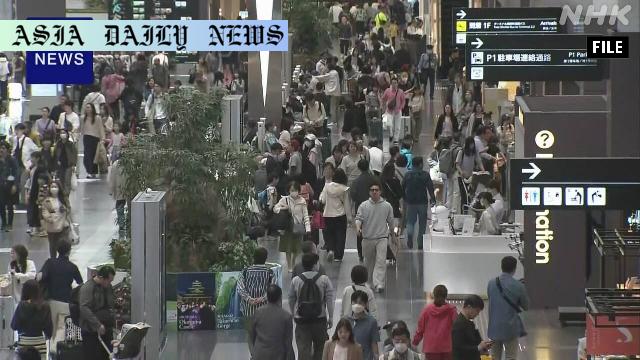Overseas travel demand has clearly recovered, diversifying travel styles and expanding global destinations for Japanese travelers.
- Overseas travel demand is rebounding strongly in Japan.
- 2.44 million Japanese expected to travel abroad this summer season.
- Popular destinations include South Korea, Europe, Taiwan, US mainland.
- Overseas travel is recovering to 90% of pre-pandemic levels.

Post-Pandemic Recovery of Overseas Travel in Japan
The overseas travel landscape in Japan is witnessing a strong recovery as more citizens are opting to travel abroad this summer. According to JTB, one of Japan’s major travel agencies, approximately 2.44 million people are expected to plan international trips between July 15 and August 31. This marks an impressive 20.8 percent increase compared to the previous summer’s statistics. Such growth is indicative of revitalized interest in global tourism, fueled by various economic and perceptual shifts post-pandemic.
Remarkably, this year’s overseas travel demand is projected to recover to almost 90 percent of the pre-pandemic levels, based on the 10-year travel average. Behind this resurgence lies the stabilization of the yen’s depreciation, coupled with a positive economic trend wherein summer bonuses have seen an upward boost. These contributing factors provide travelers in Japan with both the financial means and motivation to explore destinations that extend beyond the borders of their homeland.
Top International Destinations Gaining Traction
Data from JTB also highlights the diversity in travelers’ destination preferences. South Korea and Europe take the lead as the two most popular choices among outbound tourists. These destinations are followed by Taiwan and Southeast Asian countries, which maintain their steady appeal among Japanese travelers. Furthermore, the United States mainland has also witnessed growing interest, indicating a broadening geographical spectrum in terms of travel interests.
An intriguing trend has emerged where travelers exhibit an increasing willingness to spend more time and capital on longer journeys to farther places. Unlike the earlier inclination towards shorter and more localized travel experiences within Asia, today’s Japanese outbound travelers are gradually spreading their wings to include Europe and the U.S., likely influenced by their desire for new cultural and experiential diversities.
The Resilience of Domestic Travel
Despite the upward shift towards overseas travel, domestic tourism remains a significant component of Japan’s travel industry. With 72.2 million domestic trips anticipated this summer, the segment shows a marginal increase of 0.3 percent year-on-year. This number signifies the sustained importance of local travel amidst the expanding globalization of Japanese tourism.
While global destinations are inspiring a surge in outbound travel, domestic journeys offer their unique set of attractions, affordability, and convenience. As a result, the Japanese travel market continues to thrive holistically, ensuring a balance between international exploration and local experiences.
Future Outlook and the Evolution of Travel Preferences
The shift towards diversified travel patterns and long-haul destinations reflects a noteworthy evolution in the Japanese tourism industry. The growing trend to explore further regions demonstrates an economic and social resilience that transcends pandemic-induced challenges. Additionally, travel preferences are rapidly changing, with many individuals prioritizing rich cultural, historical, and experiential aspects while planning their journeys.
Moving forward, it will be pivotal for travel agencies and tourism boards to leverage this changing landscape by ensuring accessibility, improved financial incentives, and enhanced travel experiences for their consumers. The increasing willingness of the Japanese to spend more on international trips positions the country as an essential economic driver in the global tourism ecosystem. If current projections hold, the upcoming years may see Japan further solidifying its role as a leading contributor to worldwide travel.



Commentary
Japanese Travel Resurgence Post-Pandemic
It’s truly fascinating to observe the rebound of overseas travel in Japan after the challenging years of the pandemic. The projected growth of 20.8 percent in outbound travel signifies not only a recovery but also a rejuvenation of wanderlust among Japanese citizens. Undoubtedly, the stabilization of the yen’s value and the encouraging increase in summer bonuses have played their parts in making this possible. The resilience demonstrated by both the travel industry and its consumers is inspiring and highlights the innate human desire to explore and connect with the global community.
Diversification of Destinations: A Positive Trend
Another interesting aspect is the diversification of destinations among Japanese travelers. South Korea and Europe topping the list as preferred travel hotspots adds an intriguing layer of variety to traditional Asian-centric preferences. Additionally, the increasing popularity of long-haul destinations like the United States mainland reflects an evolving travel mindset that is more adventurous and willing to trade convenience for cultural richness.
This diversification could potentially enrich not only the individual experiences of travelers but also foster deeper international relationships. Encouraging this shift further could serve as a catalyst to Japanese tourism agencies exploring partnerships and collaborations with international travel destinations to enhance cultural exchanges.
The Balance Between Domestic and International Tourism
While the growing popularity of overseas travel grabs headlines, it is equally vital to recognize the strength and consistency of Japan’s domestic tourism market. With over 72 million individuals expected to embark on local trips this summer, Japan continues to maintain a fine balance between international exploration and enjoying the beauty of its own cultural and natural landscapes. This equilibrium ensures that both sectors grow harmoniously, benefiting the overall travel ecosystem in the country.
As the world moves forward, Japan’s efforts to revitalize and innovate within the travel sector will surely serve as a model for other nations. From economic recovery to transforming travel patterns, this journey is not merely about tourism; it’s a testament to humans’ indomitable spirit and desire to explore, connect, and grow.